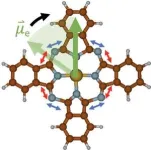(Press-News.org) When molecules are irradiated with infrared light, they begin to vibrate due to the energy supply. For Andreas Hauser from the Institute of Experimental Physics at Graz University of Technology (TU Graz), this well-known phenomenon was the starting point for considering whether these oscillations could also be used to generate magnetic fields. This is because atomic nuclei are positively charged, and when a charged particle moves, a magnetic field is created. Using the example of metal phthalocyanines – ring-shaped, planar dye molecules – Andreas Hauser and his team have now calculated that, due to their high symmetry, these molecules actually generate tiny magnetic fields in the nanometre range when infrared pulses act on them. According to the calculations, it should be possible to measure the rather low but very precisely localised field strength using nuclear magnetic resonance spectroscopy. The researchers have published their results in the Journal of the American Chemical Society.
Circular dance of the molecules
For the calculations, the team drew on preliminary work from the early days of laser spectroscopy, some of which was decades old, and used modern electron structure theory on supercomputers at the Vienna Scientific Cluster and TU Graz to calculate how phthalocyanine molecules behave when irradiated with circularly polarised infrared light. What happened was that the circularly polarised, i.e. helically twisted, light waves excite two molecular vibrations at the same time at right angles to each other. “As every rumba dancing couple knows, the right combination of forwards-backwards and left-right creates a small, closed loop. And this circular movement of each affected atomic nucleus actually creates a magnetic field, but only very locally, with dimensions in the range of a few nanometres,” says Andreas Hauser.
Molecules as circuits in quantum computers
By selectively manipulating the infrared light, it is even possible to control the strength and direction of the magnetic field, explains Andreas Hauser. This would turn the molecules into high-precision optical switches, which could perhaps also be used to build circuits for a quantum computer.
Experiments as next step
Together with colleagues from the Institute of Solid State Physics at TU Graz and a team at the University of Graz, Andreas Hauser now wants to prove experimentally that molecular magnetic fields can be generated in a controlled manner. “For proof, but also for future applications, the phthalocyanine molecule needs to be placed on a surface. However, this changes the physical conditions, which in turn influences the light-induced excitation and the characteristics of the magnetic field,” explains Andreas Hauser. “We therefore want to find a support material that has minimal impact on the desired mechanism.” In a next step, the physicist and his colleagues want to compute the interactions between the deposited phthalocyanines, the support material and the infrared light before putting the most promising variants to the test in experiments.
This research is anchored in the Field of Expertise "Advanced Materials Science", one of five strategic foci of TU Graz.
END
Switching nanomagnets using infrared lasers
Physicists at TU Graz have calculated how suitable molecules can be stimulated by infrared light pulses to form tiny magnetic fields. If this is also successful in experiments, the principle could be used in quantum computer circuits.
2024-06-11
ELSE PRESS RELEASES FROM THIS DATE:
How older people explore new spaces could suggest cognitive decline and dementia
2024-06-11
Spatial navigation – the ability to select and follow a route from one place to another – is a skill we use every day. Depending on practice, general cognitive ability, and childhood environment, some people are naturally better at this than others. But research has also shown that people’s skill in spatial navigation tends to decrease with increasing age.
This decline in navigation skill has been generally attributed to worsening spatial memory, due to changes in brain structure and function that naturally occur with age. But what if it isn’t just due to our spatial memory declining, but also to changes in how we explore a novel ...
How should Japan make use of vacant homes in old new towns?
2024-06-11
During Japan’s 1960-90 population boom, new towns sprouted up across the nation. These new towns were quiet residential neighborhoods of suburban areas, many of which are now shrinking in terms of inhabitants. They have become old new towns, aging neighborhoods amid Japan’s population decline, frequently dotted with vacant homes.
Dr. Haruka Kato, a junior associate professor at the Graduate School of Human Life and Ecology at Osaka Metropolitan University, examined the nonlinear relationship between population decline and the urban transformation of residences to other land-use plots in old new towns. His research group wanted ...
Sustainable battery technology: innovations in design, manufacturing, and fault detection
2024-06-11
In an era where sustainable energy is paramount, a groundbreaking study provides critical insights into battery health management. It meticulously examines the design, optimization, fault detection, and recycling of Lithium-ion, Lead Acid, and Nickel Metal Hydride (NiMH) batteries—crucial components for the next generation of portable devices, electric vehicles, and renewable energy systems.
As our reliance on electric vehicles and renewable energy systems grows, so does the demand for efficient and sustainable ...
Large language model in electrocatalysis
2024-06-11
Large language models, outstanding representatives of modern technology, have significant impacts on various fields of modern society. These models, constructed by billions of neurons, incorporate the extensive knowledge accumulated by humans so far, possessing the exceptional abilities to chat with people around the world fluently. Their human-like intelligence enables them to tackle various challenges of modern society and shows great potential for applications in various fields.
Recently, a research team led by Prof. Ziyun Wang from the University of Auckland in New Zealand delved into the potential applications of large language models in the field ...
Bound-state electrons synergy over photochromic high-crystalline C₃N₅ nanosheets in enhancing charge separation for photocatalytic H₂ production
2024-06-11
Photocatalytic water splitting, a sustainable energy strategy, utilizes solar energy to produce clean hydrogen fuel. While it offers a promising solution to the global energy crisis and environmental pollution, the slow kinetics of photogenerated electron-hole pairs result in low activity for most semiconductor materials, even with sacrificial agents. To that end, integrating electron traps and reactive centers could be a feasible strategy to enhance charge separation and catalytic performance.
In ...
Engagement key to eliminating prejudice: Uncovering the process of feeling understood
2024-06-11
Osaka, Japan - A research group at Osaka University has uncovered how the view of other people and groups changes when individuals feel that they are understood by others by conducting an experimental study on the relationship between Japanese and Chinese people. The study shows that the role of felt understanding largely derives from a reduction in prejudice toward the other person.
Feeling understood by other people is a crucial determinant for positive interpersonal and intergroup relationships; however, the psychology behind this determinant was not well understood.
In ...
1 in 7 adults have experienced someone threaten to share their intimate images: new research
2024-06-11
A global study on the prevalence of sexual extortion among adults has found the issue to be more widespread than initially thought.
Sexual extortion, or sextortion, is a form of image-based sexual abuse which includes making threats to share intimate photos or videos of a victim unless they comply with the perpetrator’s behavioral or financial demands.
The research, led by RMIT University in partnership with Google, surveyed over 16,000 adults across Australia, North and Central America, Europe and Asia and found 14.5% of respondents reported being victims of sextortion, while 4.8% admitted to being perpetrators.
LGBTQ+ ...
Treating rare skin diseases by transplanting healthy skin
2024-06-11
Researchers from Nagoya University Graduate School of Medicine in Japan have successfully treated the skin diseases epidermolytic ichthyosis (EI) and ichthyosis with confetti (IWC) by transplanting genetically healthy skin to inflamed areas. Transplanting healthy skin to inflamed areas has been used as a treatment option for severe burn injuries. They applied this technique from a common disease to rare diseases. Their research could pave the way for a new and effective treatment strategy for these challenging skin disorders. The study was published in the British Journal of Dermatology.
EI and IWC are rare genetic skin disorders caused by mutations in one of the two genes ...
Revealed: tricks used by opioid giant to mold doctors’ minds
2024-06-11
Opioid giant Mallinckrodt, selling more than Purdue Pharma in the US, was forced by the courts to publish more than 1.3 million internal documents.
In The BMJ today, researchers Sergio Sismondo and Maud Bernisson sift through nearly 900 contracts which together reveal a carefully coordinated effort to shape medical attitudes toward pain medicine.
Pharmaceutical companies have a long history of managing physician and public opinion, explain the authors. For example, by recruiting physicians to serve as influencers, planting articles in scientific journals, coordinating conference presentations, and developing continuing medical education (CME) courses.
Amid surging ...
Lab-grown ‘mini-guts’ could help in development of new and more personalized treatments for Crohn’s disease
2024-06-11
Cambridge scientists have grown ‘mini-guts’ in the lab to help understand Crohn’s disease, showing that ‘switches’ that modify DNA in gut cells play an important role in the disease and how it presents in patients.
The researchers say these mini-guts could in future be used to identify the best treatment for an individual patient, allowing for more precise and personalised treatments.
Crohn’s disease is a form of inflammatory bowel disease (IBD). It is a life-long condition characterised by inflammation of the digestive tract that affects around one in 350 people in the UK, with one in four presenting before the age of 18. Even at its mildest, it ...
LAST 30 PRESS RELEASES:
Decoupling the HOR enhancement on PtRu: Dynamically matching interfacial water to reaction coordinates
Sulfur isn’t poisonous when it synergistically acts with phosphine in olefins hydroformylation
URI researchers uncover molecular mechanisms behind speciation in corals
Chitin based carbon aerogel offers a cleaner way to store thermal energy
Tracing hidden sources of nitrate pollution in rapidly changing rural urban landscapes
Viruses on plastic pollution may quietly accelerate the spread of antibiotic resistance
Three UH Rainbow Babies & Children’s faculty elected to prestigious American Pediatric Society
Tunnel resilience models unveiled to aid post-earthquake recovery
Satellite communication systems: the future of 5G/6G connectivity
Space computing power networks: a new frontier for satellite technologies
Experiments advance potential of protein that makes hydrogen sulfide as a therapeutic target for Alzheimer’s disease
Examining private equity’s role in fertility care
Current Molecular Pharmacology achieves a landmark: real-time CiteScore advances to 7.2
Skeletal muscle epigenetic clocks developed using postmortem tissue from an Asian population
Estimating unemployment rates with social media data
Climate policies can backfire by eroding “green” values, study finds
Too much screen time too soon? A*STAR study links infant screen exposure to brain changes and teen anxiety
Global psychiatry mourns Professor Dan Stein, visionary who transformed mental health science across Africa and beyond
KIST develops eco-friendly palladium recovery technology to safeguard resource security
Statins significantly reduce mortality risk for adults with diabetes, regardless of cardiovascular risk
Brain immune cells may drive more damage in females than males with Alzheimer’s
Evidence-based recommendations empower clinicians to manage epilepsy in pregnancy
Fungus turns bark beetles’ defenses against them
There are new antivirals being tested for herpesviruses. Scientists now know how they work
CDI scientist, colleagues author review of global burden of fungus Candida auris
How does stroke influence speech comprehension?
B cells transiently unlock their plasticity, risking lymphoma development
Advanced AI dodel predicts spoken language outcomes in deaf children after cochlear implants
Multimodal imaging-based cerebral blood flow prediction model development in simulated microgravity
Accelerated streaming subgraph matching framework is faster, more robust, and scalable
[Press-News.org] Switching nanomagnets using infrared lasersPhysicists at TU Graz have calculated how suitable molecules can be stimulated by infrared light pulses to form tiny magnetic fields. If this is also successful in experiments, the principle could be used in quantum computer circuits.








